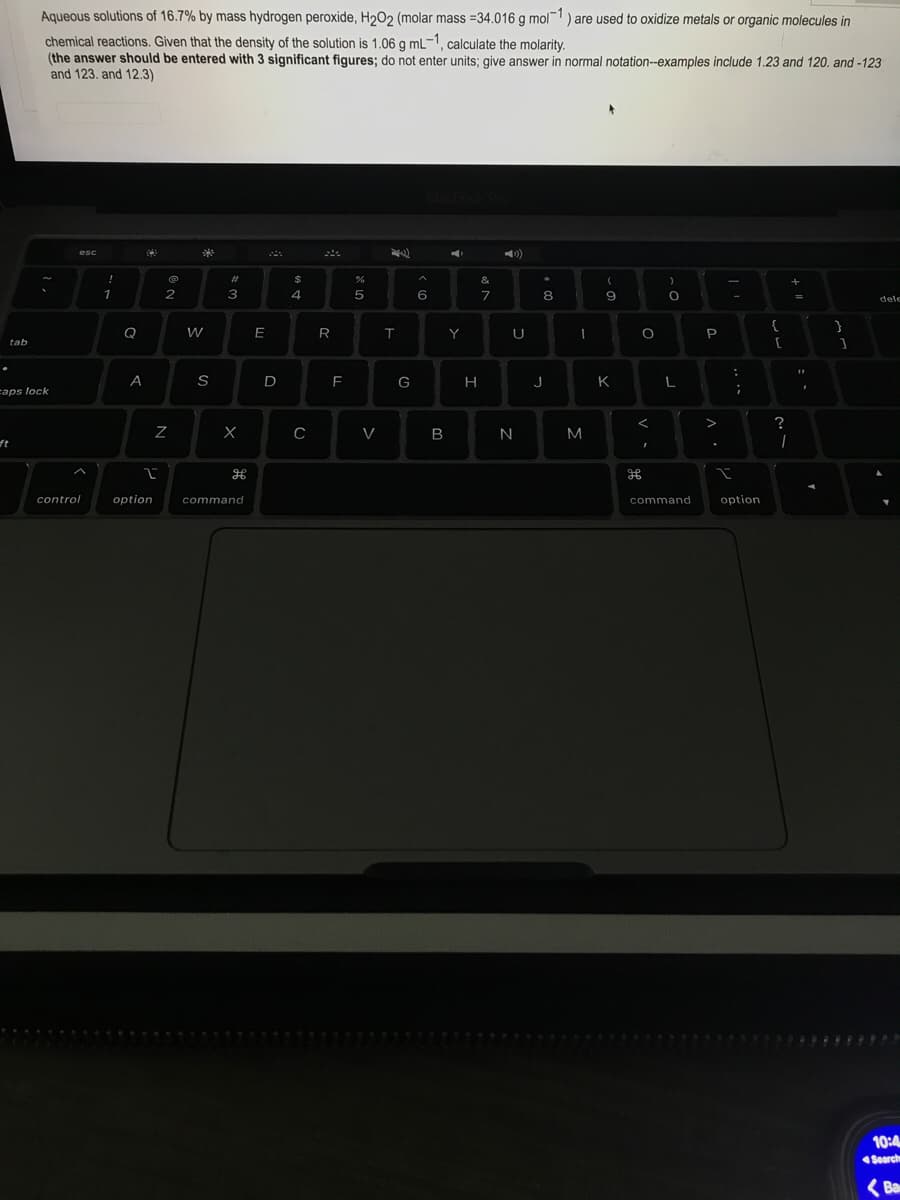Aqueous solutions of 16.7% by mass hydrogen peroxide, H202 (molar mass =34.016 g mol1) are used to oxidize metals or organic molecules in chemical reactions. Given that the density of the solution is 1.06 g mL¬1, calculate the molarity. (the answer should be entered with 3 significant figures; do not enter units; give answer in normal notation-examples include 1.23 and 120. and -123 and 123. and 12.3) esc & 1 2 6 8. 9 dele Q E T Y U A S D G H J K ck ? C M control option command command option V > LO
Aqueous solutions of 16.7% by mass hydrogen peroxide, H202 (molar mass =34.016 g mol1) are used to oxidize metals or organic molecules in chemical reactions. Given that the density of the solution is 1.06 g mL¬1, calculate the molarity. (the answer should be entered with 3 significant figures; do not enter units; give answer in normal notation-examples include 1.23 and 120. and -123 and 123. and 12.3) esc & 1 2 6 8. 9 dele Q E T Y U A S D G H J K ck ? C M control option command command option V > LO
Principles of Modern Chemistry
8th Edition
ISBN:9781305079113
Author:David W. Oxtoby, H. Pat Gillis, Laurie J. Butler
Publisher:David W. Oxtoby, H. Pat Gillis, Laurie J. Butler
Chapter15: Acid–base Equilibria
Section: Chapter Questions
Problem 98AP
Related questions
Question

Transcribed Image Text:Aqueous solutions of 16.7% by mass hydrogen peroxide, H202 (molar mass =34.016 g mol) are used to oxidize metals or organic molecules in
chemical reactions. Given that the density of the solution is 1.06 g mL-1, calculate the molarity.
(the answer should be entered with 3 significant figures; do not enter units; give answer
and 123. and 12.3)
normal notation--examples include 1.23 and 120. and -123
esc
%23
&
2
3
4
5
7
8
dele
{
}
W
E
R
Y
U
P
tab
A
S
D
F
G
J
K
L
caps lock
?
C
V
B
ft
control
option
command
command
option
10:4
Search
(Ba
Expert Solution
This question has been solved!
Explore an expertly crafted, step-by-step solution for a thorough understanding of key concepts.
Step by step
Solved in 3 steps

Knowledge Booster
Learn more about
Need a deep-dive on the concept behind this application? Look no further. Learn more about this topic, chemistry and related others by exploring similar questions and additional content below.Recommended textbooks for you

Principles of Modern Chemistry
Chemistry
ISBN:
9781305079113
Author:
David W. Oxtoby, H. Pat Gillis, Laurie J. Butler
Publisher:
Cengage Learning

Introductory Chemistry: A Foundation
Chemistry
ISBN:
9781337399425
Author:
Steven S. Zumdahl, Donald J. DeCoste
Publisher:
Cengage Learning


Principles of Modern Chemistry
Chemistry
ISBN:
9781305079113
Author:
David W. Oxtoby, H. Pat Gillis, Laurie J. Butler
Publisher:
Cengage Learning

Introductory Chemistry: A Foundation
Chemistry
ISBN:
9781337399425
Author:
Steven S. Zumdahl, Donald J. DeCoste
Publisher:
Cengage Learning


Chemistry: An Atoms First Approach
Chemistry
ISBN:
9781305079243
Author:
Steven S. Zumdahl, Susan A. Zumdahl
Publisher:
Cengage Learning

Chemistry
Chemistry
ISBN:
9781305957404
Author:
Steven S. Zumdahl, Susan A. Zumdahl, Donald J. DeCoste
Publisher:
Cengage Learning
